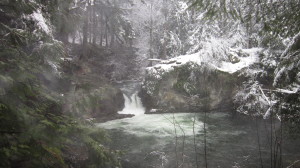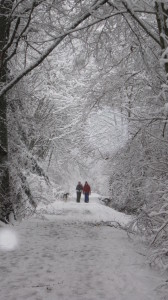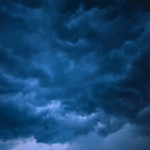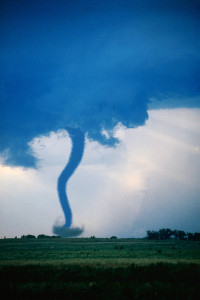 After a surprisingly heavy snowfall (for my coastal area), I decided to pull on my hiking boots and stroll the 1.5 miles to my favorite park while the scenery was coated in white.
After a surprisingly heavy snowfall (for my coastal area), I decided to pull on my hiking boots and stroll the 1.5 miles to my favorite park while the scenery was coated in white.
The trail was only a bit slippery and the frosting of snow made thick woods and waterfalls completely enchanting. The winds were calm, and the temperature hovered around the freezing point, hardly life-threatening. I was deep into my beloved woods when I noticed that other aspects of my walk might be more than a little hazardous.
 Branches overhead were so burdened with wet snow that every few minutes I heard a loud CRACK! Then a branch would crash to the ground, sometimes from as high as fifty feet in the air. I spent a fair amount of time hugging big trees as I waited for plummeting snow and debris to settle around me. The situation added an unexpected element of suspense to my outing.
Branches overhead were so burdened with wet snow that every few minutes I heard a loud CRACK! Then a branch would crash to the ground, sometimes from as high as fifty feet in the air. I spent a fair amount of time hugging big trees as I waited for plummeting snow and debris to settle around me. The situation added an unexpected element of suspense to my outing.
This was a good reminder of how much weather conditions can add to any story and help set the mood. I decided that the falling tree limbs would make a great addition to one of my next novels; now I’ve got to find an appropriate place to put that scene.
Weather can set the mood and dramatically increase the feelings you want to provoke in your readers. Although it might be a bit cliché to set your big suspense scene during a thunderstorm, flashes of lightning and claps of thunder can add a lot of tension. Delve into your memory and sort through all the weather situations you’ve experienced in your lifetime, and you’ll think of interesting weather elements to add to scenes.
 I included a thunderstorm in my novel Endangered, but the main threat in that Utah setting is peripheral to the storm: when it’s raining on the high plateau, a flash flood will soon be roaring through the slot canyons. An earthquake opens my romantic suspense Shaken, and my heroine Elisa is pinned to the ground by a falling tree. But again, the earthquake isn’t the real threat; it’s the cool damp weather, and because she is trapped, she soon has to battle hypothermia as well as a broken leg.
I included a thunderstorm in my novel Endangered, but the main threat in that Utah setting is peripheral to the storm: when it’s raining on the high plateau, a flash flood will soon be roaring through the slot canyons. An earthquake opens my romantic suspense Shaken, and my heroine Elisa is pinned to the ground by a falling tree. But again, the earthquake isn’t the real threat; it’s the cool damp weather, and because she is trapped, she soon has to battle hypothermia as well as a broken leg.
Pouring rain and driving snow lessen visibility and can add suspense when a character needs to be on the move outside, or if that character is on guard against a threat coming from outdoors. If your characters are indoors, bad weather outside can make a scene feel more “cozy” and romantic.
 Tornado conditions are always anxiety-provoking: I once had the occasion to watch as the change in air pressure caused the giant plate glass panels at the front of a store to bow inward. (Fortunately some doors flew open and equalized the pressure before the windows shattered, otherwise I might not be here to write this.)
Tornado conditions are always anxiety-provoking: I once had the occasion to watch as the change in air pressure caused the giant plate glass panels at the front of a store to bow inward. (Fortunately some doors flew open and equalized the pressure before the windows shattered, otherwise I might not be here to write this.)
Sunshine and gentle breezes can add to a pleasant scene. Relentless baking sun and drying winds are a different story.
You see what I mean. The snow is all gone from my neighborhood now, but I’ll remember to add those cracking limbs to a future book. And maybe I’ll find a place for those dramatic bowed windows, too, although I no longer live in tornado country.
 So if you feel the story you’re writing is lacking in some respect, think about how you could use the weather. In real life, we all deal with the weather every day.
So if you feel the story you’re writing is lacking in some respect, think about how you could use the weather. In real life, we all deal with the weather every day.
Be sure the characters in your books do, too.